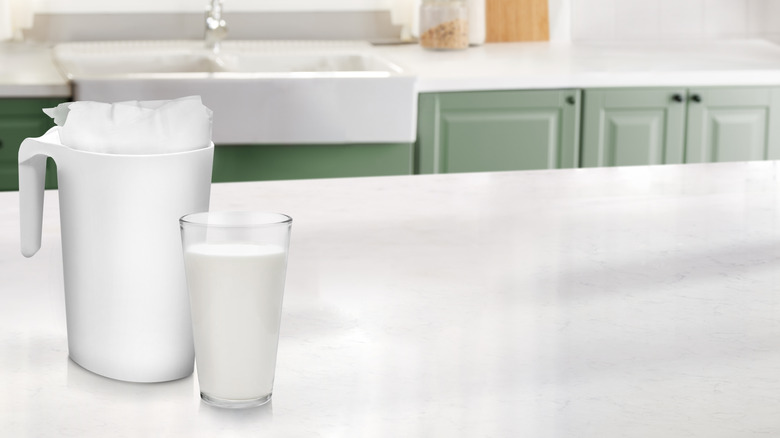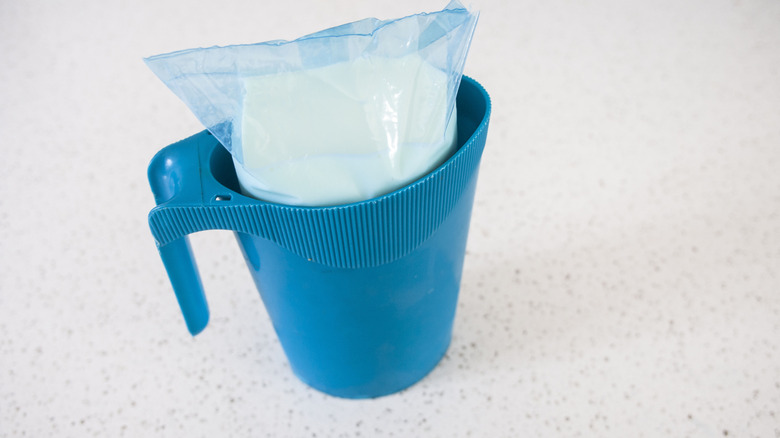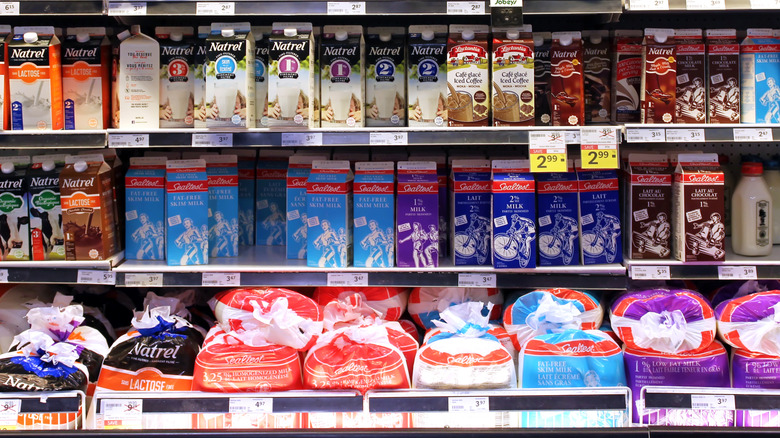Why Can You Find Bagged Milk In Canada?
You may have seen wine sold in a bag, but have you ever heard of milk in a bag? Even though Americans love their milk — each person drinks an average of about 15 gallons of it per year, per Statista — you won't typically find it by the bag in U.S. grocery stores. However, plastic pouches are among the most bizarre things that exist in Canada, and (in some places) are a more common vessel for lactose than classic cartons or jugs.
So what's the deal with bagged milk in Canada, eh? If you're accustomed to pouring your milk from a jug, it may seem bizarre and unnecessary to pour it from a bag unless there's some cost effective, environmentally friendly, or functional reason for doing so. In reality, none of those reasons ring true. While milk bags debuted on Canadian grocery store shelves during the 1960s, the rise in their popularity didn't come until the country's conversion to the metric system in the 1970s.
What's the metric system got to do with it?
According to the CBC, Canada started peddling pouches of milk back in 1969. Sold alongside classic milk containers, milk bags cost less to manufacture, but weren't necessarily cheaper for consumers (costing about 6 cents more than jugs). Despite the inflated cost of the bags, what might have been an experimental phase in milk storage became a lasting phenomenon when Canada gradually converted to the metric system starting in 1971.
Before the conversion to the metric system, milk bags were measured in imperial units and sold in packs of three 1-quart pouches stored within a larger bag. After the conversion from imperial units to metric units, dairy producers were prompted to sell milk in ½-liter increments, which meant they needed to change the size of the containers. Adjusting the size of milk pouches proved much easier (and cheaper) than manufacturing larger jugs or glass bottles, resulting in the switch from 1-quart bags to 1.33-quart bags, sold in packs of three for a total of 4 liters. With more milk bags being produced, they steadily became a common kitchen staple in Canada.
Where can you find milk bags in Canada?
In the 1970s, milk bags were everywhere in Canada. But though they were readily available and cheaper to manufacture, they weren't necessarily easier for consumers to use and store. (Just imagine snipping open a fresh bag of milk and trying to prop it up in the refrigerator without it spilling all over the place). Instead of picking up a jug at the store and calling it a day, consumers had the added task of buying a plastic pitcher to store the milk bags once they were opened.
Despite the challenges they posed for convenience, many Canadian households had grown accustomed to buying milk bags. However, they became harder to find during the 1980s after the government loosened its metric system regulations, prompting the milk industry to move back to jugs. In addition, hard plastic became cheaper, making it easier and more cost effective to manufacture the jugs anyway.
As a result, some parts of Canada (such as Alberta and British Columbia) ditched the bag altogether. Yet other provinces are still milking it to this day. According to RCI Canadian News, Ontario retailers remained faithful to the bag due to a regulation that required them to provide a recycling system or pay a deposit for 4-litre jugs. Bags didn't have this regulation, and thus cost less to sell. Though the regulation was lifted in 2018, Ontario continues to offer milk by the bag, along with stores in Quebec and Nova Scotia, due to consumer demand. So, while Canadian milk packaging practices may have many Americans scratching their heads, the power of the pouch is strong across the border.


